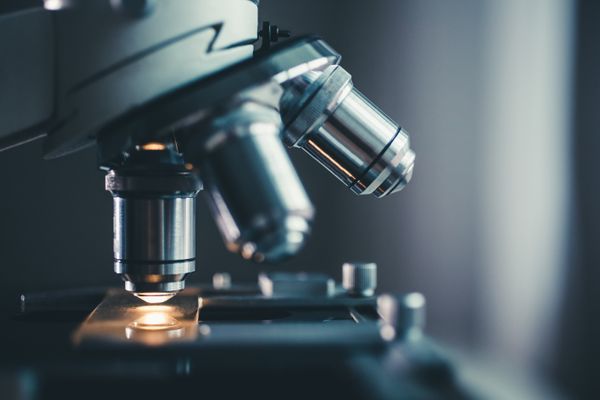3.2.6
Dissection
Lung Dissection
Lung Dissection
It is important to understand how to dissect the gas exchange systems in the animals. The steps involved in dissecting the lungs are:


1) Use the correct apparatus
1) Use the correct apparatus
- Dissection tools should be sterilised using ethanol or heating.
- The tools must be sharp to allow clean cuts.
- Clean cuts ensure the structures can easily be cut open.
- Wear gloves and a lab coat.
-min,h_400,q_80,w_640.png)
-min,h_400,q_80,w_640.png)
2) Identify the trachea
2) Identify the trachea
- Lay the lungs in front of you.
- The trachea should be visible without making any cuts.
- The trachea is the tube that runs into the lungs.
- The trachea is surrounded by C-shaped cartilage rings.
-min,h_400,q_80,w_640.png)
-min,h_400,q_80,w_640.png)
3) Open the trachea
3) Open the trachea
- Open up the trachea by cutting down the gap in the C-shaped cartilage.
- Cartilage is difficult to cut through so cutting through the gap (smooth muscle) will be easier.
-min,h_400,q_80,w_640.png)
-min,h_400,q_80,w_640.png)
4) Cut open the bronchi
4) Cut open the bronchi
- You should be able to see the trachea split into two bronchi.
- Continue to cut down the trachea and into one of the bronchi.
- The bronchi branch into many smaller branches over the lungs.
- The small branches are the bronchioles.
-min,h_400,q_80,w_640.png)
-min,h_400,q_80,w_640.png)
5) Feel the tissue
5) Feel the tissue
- The lung tissue should feel spongy.
- The tissue contains millions of alveoli that are filled with air.


6) Disinfect
6) Disinfect
- After the dissection has been completed, disinfect your hands and the surrounding area.
Fish Dissection
Fish Dissection
It is important to understand how to dissect the gas exchange systems in the animals. The steps involved in dissecting the gills in fish are:


1) Use the correct apparatus
1) Use the correct apparatus
- Dissection tools should be sterilised using ethanol or heating.
- The tools must be sharp to allow clean cuts.
- Clean cuts ensure the structures can easily be cut open.
- Wear gloves and a lab coat.


2) Identify the gills
2) Identify the gills
- Lay the fish in front of you.
- The gills are located underneath a bony flap called the operculum.
- The gills can be found on either side of the head.


3) Remove the gills
3) Remove the gills
- Remove the gills by pushing back the operculum and carefully cutting out the gills.
- The gills are supported by the gill arches.
- The gill arches can be cut out by cutting through the bone at either end.
- The bones should be easy to cut through with sharp scissors.


4) Locate the gill filaments
4) Locate the gill filaments
- The gills are made up of many folds called gill filaments.
- The gill filaments should be visible along the gills.


5) Disinfect
5) Disinfect
- After the dissection has been completed, disinfect your hands and the surrounding area.
Insect Dissection
Insect Dissection
It is important to understand how to dissect the gas exchange systems in the animals. The steps involved in dissecting the tracheae insects are:


1) Use the correct apparatus
1) Use the correct apparatus
- Dissection tools should be sterilised using ethanol or heating.
- The tools must be sharp to allow clean cuts.
- Clean cuts ensure the structures can easily be cut open.
- Wear gloves and a lab coat.


2) Fix the insect
2) Fix the insect
- Insects are very small animals so it can be difficult to identify the gaseous exchange system.
- To make the dissection easier, fix the insect to the dissection board using dissection pins.
- Dissecting a larger insect (e.g. a grasshopper) will also make the dissection clearer.


3) Remove the exoskeleton
3) Remove the exoskeleton
- The exoskeleton is the hard casing around insects.
- Carefully cut away the exoskeleton by cutting along the abdomen.


4) Locate the tracheae
4) Locate the tracheae
- The tracheae can be identified by filling the abdomen of the insect with a saline solution.
- The saline solution causes the tracheae to appear as small, grey tubes.


5) Examine the tracheae
5) Examine the tracheae
- Use an optical microscope to examine the tracheae in more detail.
- The microscope will show rings of chitin in the tracheae.


6) Disinfect
6) Disinfect
- After the dissection has been completed, disinfect your hands and the surrounding area.
1Biological Molecules
1.1Monomers & Polymers
1.2Carbohydrates
1.3Lipids
1.4Proteins
1.4.1The Peptide Chain
1.4.2Investigating Proteins
1.4.3Primary & Secondary Protein Structure
1.4.4Tertiary & Quaternary Protein Structure
1.4.5Enzymes
1.4.6Factors Affecting Enzyme Activity
1.4.7Enzyme-Controlled Reactions
1.4.8End of Topic Test - Lipids & Proteins
1.4.9A-A* (AO3/4) - Enzymes
1.4.10A-A* (AO3/4) - Proteins
1.4.11Diagnostic Misconceptions - Enzyme Inhibitors
1.5Nucleic Acids
1.6ATP
1.7Water
1.8Inorganic Ions
2Cells
2.1Cell Structure
2.2Mitosis & Cancer
2.3Transport Across Cell Membrane
2.4Cell Recognition & the Immune System
2.4.1Immune System
2.4.2Phagocytosis
2.4.3T Lymphocytes
2.4.4B Lymphocytes
2.4.5Antibodies
2.4.6Primary & Secondary Response
2.4.7Vaccines
2.4.8HIV
2.4.9Ethical Issues
2.4.10End of Topic Test - Immune System
2.4.11Exam-Style Question - Immune System
2.4.12A-A* (AO3/4) - Immune System
2.4.13Diagnostic Misconceptions - Humoral vs Cellular
3Substance Exchange
3.1Surface Area to Volume Ratio
3.2Gas Exchange
3.3Digestion & Absorption
3.4Mass Transport
3.4.1Haemoglobin
3.4.2Oxygen Transport
3.4.3The Circulatory System
3.4.4The Heart
3.4.5Blood Vessels
3.4.6Cardiovascular Disease
3.4.7Heart Dissection
3.4.8Xylem
3.4.9Phloem
3.4.10Investigating Plant Transport
3.4.11End of Topic Test - Mass Transport
3.4.12A-A* (AO3/4) - Mass Transport
3.4.13Diagnostic Misconceptions - Concentration Gradient
3.4.14Diagnostic Misconceptions - Cardiac Cycle
3.4.15Diagnostic Misconceptions - Carrying Capacity
3.4.16Diagnostic Misconceptions - Translocation
4Genetic Information & Variation
4.1DNA, Genes & Chromosomes
4.2DNA & Protein Synthesis
4.3Mutations & Meiosis
4.4Genetic Diversity & Adaptation
4.5Species & Taxonomy
4.6Biodiversity Within a Community
4.7Investigating Diversity
5Energy Transfers (A2 only)
5.1Photosynthesis
5.1.1Overview of Photosynthesis
5.1.2Photoionisation of Chlorophyll
5.1.3Production of ATP & Reduced NADP
5.1.4Cyclic Photophosphorylation
5.1.5Light-Independent Reaction
5.1.6A-A* (AO3/4) - Photosynthesis Reactions
5.1.7Limiting Factors
5.1.8Photosynthesis Experiments
5.1.9End of Topic Test - Photosynthesis
5.1.10A-A* (AO3/4) - Photosynthesis
5.2Respiration
5.2.1Overview of Respiration
5.2.2Anaerobic Respiration
5.2.3A-A* (AO3/4) - Anaerobic Respiration
5.2.4The Link Reaction
5.2.5The Krebs Cycle
5.2.6Oxidative Phosphorylation
5.2.7Respiration Experiments
5.2.8End of Topic Test - Respiration
5.2.9A-A* (AO3/4) - Respiration
5.2.10Diagnostic Misconceptions - Aerobic vs Anaerobic
5.3Energy & Ecosystems
6Responding to Change (A2 only)
6.1Nervous Communication
6.2Nervous Coordination
6.3Muscle Contraction
6.4Homeostasis
6.4.1Overview of Homeostasis
6.4.2Blood Glucose Concentration
6.4.3Controlling Blood Glucose Concentration
6.4.4End of Topic Test - Blood Glucose
6.4.5Primary & Secondary Messengers
6.4.6Diabetes Mellitus
6.4.7Measuring Glucose Concentration
6.4.8Osmoregulation
6.4.9Controlling Blood Water Potential
6.4.10ADH
6.4.11End of Topic Test - Diabetes & Osmoregulation
6.4.12A-A* (AO3/4) - Homeostasis
6.4.13Diagnostic Misconceptions - Effect of ADH
7Genetics & Ecosystems (A2 only)
7.1Genetics
7.2Populations
7.3Evolution
7.3.1Variation
7.3.2Natural Selection & Evolution
7.3.3End of Topic Test - Populations & Evolution
7.3.4Types of Selection
7.3.5Types of Selection Summary
7.3.6Overview of Speciation
7.3.7Causes of Speciation
7.3.8Diversity
7.3.9End of Topic Test - Selection & Speciation
7.3.10A-A* (AO3/4) - Populations & Evolution
7.3.11Diagnostic Misconceptions - Types of Speciation
8The Control of Gene Expression (A2 only)
8.1Mutation
8.2Gene Expression
8.2.1Stem Cells
8.2.2Stem Cells in Disease
8.2.3End of Topic Test - Mutation & Gene Epression
8.2.4A-A* (AO3/4) - Mutation & Stem Cells
8.2.5Regulating Transcription
8.2.6Epigenetics
8.2.7Epigenetics & Disease
8.2.8Regulating Translation
8.2.9Experimental Data
8.2.10End of Topic Test - Transcription & Translation
8.2.11Tumours
8.2.12Correlations & Causes
8.2.13Prevention & Treatment
8.2.14End of Topic Test - Cancer
8.2.15A-A* (AO3/4) - Gene Expression & Cancer
8.3Genome Projects
Jump to other topics
1Biological Molecules
1.1Monomers & Polymers
1.2Carbohydrates
1.3Lipids
1.4Proteins
1.4.1The Peptide Chain
1.4.2Investigating Proteins
1.4.3Primary & Secondary Protein Structure
1.4.4Tertiary & Quaternary Protein Structure
1.4.5Enzymes
1.4.6Factors Affecting Enzyme Activity
1.4.7Enzyme-Controlled Reactions
1.4.8End of Topic Test - Lipids & Proteins
1.4.9A-A* (AO3/4) - Enzymes
1.4.10A-A* (AO3/4) - Proteins
1.4.11Diagnostic Misconceptions - Enzyme Inhibitors
1.5Nucleic Acids
1.6ATP
1.7Water
1.8Inorganic Ions
2Cells
2.1Cell Structure
2.2Mitosis & Cancer
2.3Transport Across Cell Membrane
2.4Cell Recognition & the Immune System
2.4.1Immune System
2.4.2Phagocytosis
2.4.3T Lymphocytes
2.4.4B Lymphocytes
2.4.5Antibodies
2.4.6Primary & Secondary Response
2.4.7Vaccines
2.4.8HIV
2.4.9Ethical Issues
2.4.10End of Topic Test - Immune System
2.4.11Exam-Style Question - Immune System
2.4.12A-A* (AO3/4) - Immune System
2.4.13Diagnostic Misconceptions - Humoral vs Cellular
3Substance Exchange
3.1Surface Area to Volume Ratio
3.2Gas Exchange
3.3Digestion & Absorption
3.4Mass Transport
3.4.1Haemoglobin
3.4.2Oxygen Transport
3.4.3The Circulatory System
3.4.4The Heart
3.4.5Blood Vessels
3.4.6Cardiovascular Disease
3.4.7Heart Dissection
3.4.8Xylem
3.4.9Phloem
3.4.10Investigating Plant Transport
3.4.11End of Topic Test - Mass Transport
3.4.12A-A* (AO3/4) - Mass Transport
3.4.13Diagnostic Misconceptions - Concentration Gradient
3.4.14Diagnostic Misconceptions - Cardiac Cycle
3.4.15Diagnostic Misconceptions - Carrying Capacity
3.4.16Diagnostic Misconceptions - Translocation
4Genetic Information & Variation
4.1DNA, Genes & Chromosomes
4.2DNA & Protein Synthesis
4.3Mutations & Meiosis
4.4Genetic Diversity & Adaptation
4.5Species & Taxonomy
4.6Biodiversity Within a Community
4.7Investigating Diversity
5Energy Transfers (A2 only)
5.1Photosynthesis
5.1.1Overview of Photosynthesis
5.1.2Photoionisation of Chlorophyll
5.1.3Production of ATP & Reduced NADP
5.1.4Cyclic Photophosphorylation
5.1.5Light-Independent Reaction
5.1.6A-A* (AO3/4) - Photosynthesis Reactions
5.1.7Limiting Factors
5.1.8Photosynthesis Experiments
5.1.9End of Topic Test - Photosynthesis
5.1.10A-A* (AO3/4) - Photosynthesis
5.2Respiration
5.2.1Overview of Respiration
5.2.2Anaerobic Respiration
5.2.3A-A* (AO3/4) - Anaerobic Respiration
5.2.4The Link Reaction
5.2.5The Krebs Cycle
5.2.6Oxidative Phosphorylation
5.2.7Respiration Experiments
5.2.8End of Topic Test - Respiration
5.2.9A-A* (AO3/4) - Respiration
5.2.10Diagnostic Misconceptions - Aerobic vs Anaerobic
5.3Energy & Ecosystems
6Responding to Change (A2 only)
6.1Nervous Communication
6.2Nervous Coordination
6.3Muscle Contraction
6.4Homeostasis
6.4.1Overview of Homeostasis
6.4.2Blood Glucose Concentration
6.4.3Controlling Blood Glucose Concentration
6.4.4End of Topic Test - Blood Glucose
6.4.5Primary & Secondary Messengers
6.4.6Diabetes Mellitus
6.4.7Measuring Glucose Concentration
6.4.8Osmoregulation
6.4.9Controlling Blood Water Potential
6.4.10ADH
6.4.11End of Topic Test - Diabetes & Osmoregulation
6.4.12A-A* (AO3/4) - Homeostasis
6.4.13Diagnostic Misconceptions - Effect of ADH
7Genetics & Ecosystems (A2 only)
7.1Genetics
7.2Populations
7.3Evolution
7.3.1Variation
7.3.2Natural Selection & Evolution
7.3.3End of Topic Test - Populations & Evolution
7.3.4Types of Selection
7.3.5Types of Selection Summary
7.3.6Overview of Speciation
7.3.7Causes of Speciation
7.3.8Diversity
7.3.9End of Topic Test - Selection & Speciation
7.3.10A-A* (AO3/4) - Populations & Evolution
7.3.11Diagnostic Misconceptions - Types of Speciation
8The Control of Gene Expression (A2 only)
8.1Mutation
8.2Gene Expression
8.2.1Stem Cells
8.2.2Stem Cells in Disease
8.2.3End of Topic Test - Mutation & Gene Epression
8.2.4A-A* (AO3/4) - Mutation & Stem Cells
8.2.5Regulating Transcription
8.2.6Epigenetics
8.2.7Epigenetics & Disease
8.2.8Regulating Translation
8.2.9Experimental Data
8.2.10End of Topic Test - Transcription & Translation
8.2.11Tumours
8.2.12Correlations & Causes
8.2.13Prevention & Treatment
8.2.14End of Topic Test - Cancer
8.2.15A-A* (AO3/4) - Gene Expression & Cancer
8.3Genome Projects
Unlock your full potential with Seneca Premium
Unlimited access to 10,000+ open-ended exam questions
Mini-mock exams based on your study history
Unlock 800+ premium courses & e-books